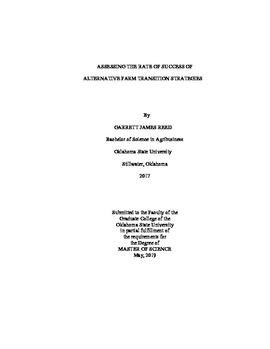| dc.contributor.advisor | Ferrell, Shannon L. | |
| dc.contributor.author | Reed, Garrett James | |
| dc.date.accessioned | 2019-10-25T20:25:22Z | |
| dc.date.available | 2019-10-25T20:25:22Z | |
| dc.date.issued | 2019-05-01 | |
| dc.identifier.uri | https://hdl.handle.net/11244/321608 | |
| dc.description.abstract | Research suggests only 30 percent of family owned businesses successfully transfer from the founding generation to the second generation. These success rates continue to decline when transferring to subsequent generations. Development of a decision tool to assist in making choices about strategies best allowing farm families to keep the farm in operation and satisfy heirs could reduce the risk of conflict with respect to the plan's implementation. The question is, what farm transition strategies reduce farm financial stress? A representative Oklahoma farm, family, and set of farm transition strategies are developed. Each strategy is imposed on the model farm subject to time, equity, and cash flow demands. Net farm income and the strategy's cash flow demands are used to determine the plan's feasibility. A Monte Carlo simulation is then utilized to consider variability in net farm income. Each strategy is simulated 500 times. The probability of success for each alternative strategy is then calculated by the number of successful transitions divided by the total number of iterations, based on criteria for leverage and cash flow. Results found strategies with an equal division of assets functionally requiring repurchases of assets from off-farm siblings are more challenging to accomplish. More successful strategies incorporated placing operating and land assets in separate legal entities, with both heirs owning the land entity. Creating financial assets either equal to the value or equal to one-half the value of the operating entity to give to the off-farm heir proved to be more successful. Another approach consisted of a lifetime farm business transfer in which the farm heir purchases shares of the operating entity each year, with help from the preceding generation when funds are deficient. At the end of the transition, cash reserves are split amongst heirs and the heirs are equal owners in the land entity. | |
| dc.format | application/pdf | |
| dc.language | en_US | |
| dc.rights | Copyright is held by the author who has granted the Oklahoma State University Library the non-exclusive right to share this material in its institutional repository. Contact Digital Library Services at lib-dls@okstate.edu or 405-744-9161 for the permission policy on the use, reproduction or distribution of this material. | |
| dc.title | Assessing the Rate of Success of Alternative Farm Transition Strategies | |
| dc.contributor.committeeMember | Jones, Rodney | |
| dc.contributor.committeeMember | DeVuyst, Eric | |
| osu.filename | Reed_okstate_0664M_16219.pdf | |
| osu.accesstype | Open Access | |
| dc.type.genre | Thesis | |
| dc.type.material | Text | |
| dc.subject.keywords | agriculture | |
| dc.subject.keywords | farm | |
| dc.subject.keywords | planning | |
| dc.subject.keywords | succession | |
| dc.subject.keywords | transition | |
| thesis.degree.discipline | Agricultural Economics | |
| thesis.degree.grantor | Oklahoma State University | |
